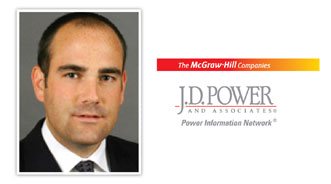J.D. Power: July Sales Up, but Pressures Still Apply

By subscribing, you agree to receive communications from Auto Remarketing and our partners in accordance with our Privacy Policy. We may share your information with select partners and sponsors who may contact you about their products and services. You may unsubscribe at any time.
WESTLAKE VILLAGE, Calif. –
So far this month, although new retail sales have picked up the pace from June and May, various downward pressures appear to be keeping sales at bay.
The market still hasn’t returned to the strength it saw during the first few months of 2011, according to J.D. Power and Associates.
The firm is forecasting July retail new-car sales of 913,900 vehicles. The resulting seasonally adjusted annualized rate would be 9.8 million units, stronger than a month ago, but still “under pressure from many variables,” J.D. Power pointed out.
Pushing the market down, for example, is the supply level — which has risen, but is still “notably low” — as well as incentive levels that have remained unchanged from a month ago.
Outside factors also appear to be playing a role, too, the firm suggested.
“While July’s selling rate is slated to finish higher than June, consumers continue to face obstacles in their willingness and ability to purchase a new vehicle,” stated Jeff Schuster, J.D. Power’s executive director of global forecasting.
Subscribe to Auto Remarketing to stay informed and stay ahead.
By subscribing, you agree to receive communications from Auto Remarketing and our partners in accordance with our Privacy Policy. We may share your information with select partners and sponsors who may contact you about their products and services. You may unsubscribe at any time.
“The ongoing debate regarding the debt ceiling and stagnant economy are creating added pressure on top of a generally weaker vehicle sales environment,” he added.
The 9.8 million SAAR expected for July certainly is a pickup from the 9.3 million level spotted during both May and June. However, the market hovered in the 10 million to 11 million range in the first four months of the year, hitting a SAAR of 11.1 million in February.
As far as total light-vehicle sales — including fleet and retail — J.D. Power believes they will reach almost 1.09 million vehicles in July.
This would be an 8-percent year-over-year hike and compares favorably to the more than 1.05 million sold last month.
For fleet specifically, J.D. Power is projecting 174,000 sales for July, which would be a 16-percent share of the market. July usually is a soft month in the fleet segment, the firm noted.
The overall total SAAR for July is forecasted to be 11.9 million, versus 11.5 million a year ago and 11.4 million in June.
Looking Forward
Offering its projections for the second half of the year, J.D. Power said the retail SAAR is likely to average 10.7 million. This compares to the first-half average of 10.3 million units.
The firm is forecasting a second-half total SAAR of 13.2 million, versus the 12.5 million unit pace notched during the first six months. J.D. Power is keeping its full-year forecasts for retail (10.5 million units) and total sales (12.9 million) steady.
“While the second half of 2011 is expected to regain momentum from earlier in the year, light-vehicle sales in July have yet to set the expected pace for a more robust recovery,” said John Humphrey, senior vice president of automotive operations at J.D. Power.
“However, with improvements in inventory and continued increases in credit availability, we remain optimistic that the recovery will get back on track as the industry manages through the current environment,” Humphrey added.
Production Totals
Next up, analysts delved into production trends.
Japanese automakers are seeing some relief from the production disruptions caused by the disasters earlier this year, with their North American production getting restored to typical strength. The firm is anticipating a speedier recovery in the second half for Japanese brands.
Overall, J.D. Power found that North America production for the auto industry reached 6.4 million units in the first half. This marks an 8-percent rise over the 5.9 million vehicles built in the first half of last year.
J.D. Power believes full-year production in North America will climb 9 percent and hit 12.9 million vehicles.
Analysts spotted an inventory level at 54 days’ supply when the month kicked off, whereas June’s supply was 49 days.
Breaking it down, trucks (67 days’ supply) were more plentiful than cars (43 days’ supply) at the beginning of July. Officials pointed out that levels of supply less than 25 days had been found among various compact models (like the Toyota Prius, Ford Focus and Honda Civic). This could hurt sales of these models, they said.
Continuing along, the firm pointed out that the 2012 model-year class of vehicles remains on the upswing, noting that this class commanded almost 12 percent of the retail sales market as of the middle of the month.
So far in July, the automakers where 2012 models command the greatest share of new-vehicle sales are Hyundai (42 percent) and Ford (16 percent).


